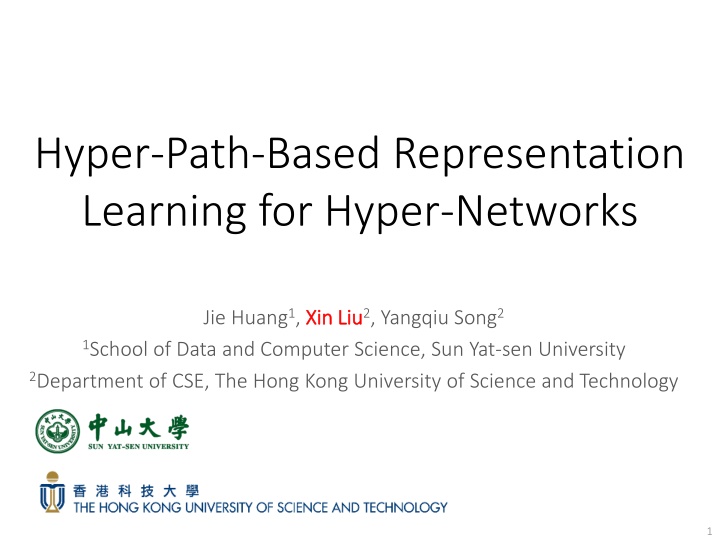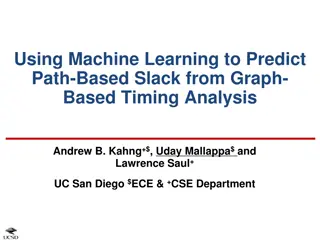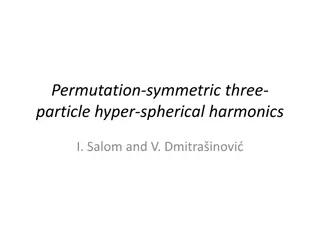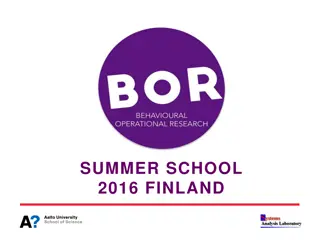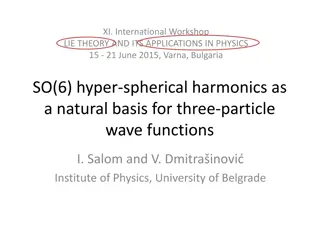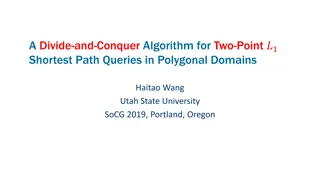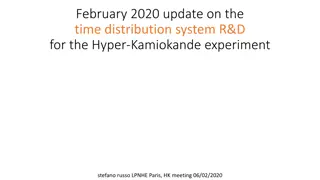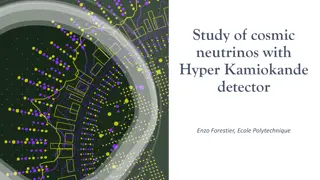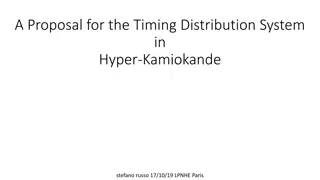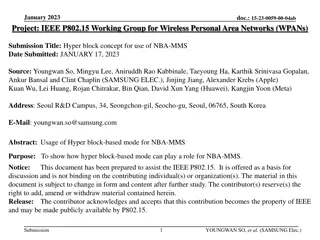Hyper-Path-Based Representation Learning for Hyper-Networks
Real applications represented as hyper-networks connecting nodes in diverse relationships. Explore hyperedge concepts, degrees of indecomposability, and methods for hyper-network embedding.
Download Presentation

Please find below an Image/Link to download the presentation.
The content on the website is provided AS IS for your information and personal use only. It may not be sold, licensed, or shared on other websites without obtaining consent from the author.If you encounter any issues during the download, it is possible that the publisher has removed the file from their server.
You are allowed to download the files provided on this website for personal or commercial use, subject to the condition that they are used lawfully. All files are the property of their respective owners.
The content on the website is provided AS IS for your information and personal use only. It may not be sold, licensed, or shared on other websites without obtaining consent from the author.
E N D
Presentation Transcript
Hyper-Path-Based Representation Learning for Hyper-Networks Jie Huang1, Xin Liu Xin Liu2, Yangqiu Song2 1School of Data and Computer Science, Sun Yat-sen University 2Department of CSE, The Hong Kong University of Science and Technology 1
Many Real Applications can be Represented as Hyper-Networks Rash Rash L Li ipitor pitor Chantix Chantix Drug Drug hypersensitivity hypersensitivity Muscular Muscular weakness weakness Bob Bob Alice Alice Death Death (user, drug, reaction) hyper-network 2
Many Real Applications can be Represented as Hyper-Networks Alice Alice Sci Sci- -fi fi philosophy philosophy Bob Bob The Matrix The Matrix (1999) (1999) Inception Inception (2010) (2010) (user, movie, tag) hyper-network 3
Hyperedge in Hyper-Networks Hyperedge: connecting more than two nodes Indecomposability: a strong relationship cannot be decomposed to binary relations (Tu et al., AAAI 2018) ? Ke Tu, Peng Cui, Xiao Wang, Fei Wang, and Wenwu Zhu. 2018. Structural deep embedding for hyper-networks. In AAAI. 426 433. 4
Degree of Indecomposability (user, drug, reaction) hyper-network: reaction reaction drug user user drug (user, movie, tag) hyper-network: tag tag user movie user movie Different hyper-networks may have different degrees of indecomposability 5
Existing Methods Converting hyper-networks to conventional pairwise networks and applying network embedding methods Star expansion (Agarwal et al., ICML'2006) Clique expansion (Sun et al., KDD'2008) Recent representation learning methods (including deep learning) DHNE (Tu et al. , AAAI'2018) HHNE (Baytas et al. ICDM'2018) HGE (Yu et al. CIKM'2018) Problem Problem: less consideration of the degrees of indecomposability Sameer Agarwal, Kristin Branson, and Serge Belongie. 2006. Higher order learning with graphs. In ICML. ACM, 17 24 Liang Sun, Shuiwang Ji, and Jieping Ye. 2008. Hypergraph spectral learning for multi-label classification. In SIGKDD. ACM, 668 676. Ke Tu, Peng Cui, Xiao Wang, Fei Wang, and Wenwu Zhu. 2018. Structural deep embedding for hyper-networks. In AAAI. 426 433. Inci M Baytas, Cao Xiao, Fei Wang, Anil K Jain, and Jiayu Zhou. 2018. Heterogeneous Hyper-Network Embedding. In ICDM. IEEE, 875 880. Chia-An Yu, Ching-Lun Tai, Tak-Shing Chan, and Yi-Hsuan Yang. 2018. Modeling Multi-way Relations with Hypergraph Embedding. In CIKM. ACM, 1707 1710. 6
Indecomposable Factor Coupled edge pair: if one specific node is removed, all other nodes in a hyperedge can be covered by another hyperedge (?1,?2) is a coupled edge pair (removing ?1,?2) (?1,?3) is not a coupled edge pair (?2,?3) is not a coupled edge pair Indecomposable Factor 1 | ??????| ? ???????1( ,?,?) ?+1 | | ? ?1( ,?,?) ?+ ??= , where 0 < ? 1 is a smoothing hyperparameter, ?????? is a hyperedge set generated randomly from ? of ?, ?1( ,?,?) is an indicator function whether there is another hyperedge ? such that (?,? ) is a coupled edge pair and the removed node type is ?. ?1 ,?1,? = ?1 ,?2,? = 1 ?1 ,?1,? = ?1 ,?2,? = 0 ?1 ,?1,? = ?1 ,?2,? = 0 7
Indecomposable Factor Indecomposable Factor 1 | ??????| ? ???????1( , ?,?) ? +1 | | ? ?1( ,?,?) ? + ??= Target graph: Random graph: 1 ? ?1( ,?,?) =1 ? ?1( ,?,?) =1 ? ?1( ,?,?) =1 31 + 1 + 0 =2 1 61 + 1 + 1 + 1 + 0 + 1 =5 ?1( ,?,?) =1 ?1( ,?,?) =1 | | 1 | | 1 | | | ??????| 1 | ??????| 1 | ??????| ?+1 2 ?+0= 1 + 3 6 ? ?????? 60 + 1 + 1 + 0 + 1 + 0 =1 ?1( ,?,?) =1 60 + 0 + 0 + 0 + 0 = 0 30 + 0 + 0 = 0 2 ? ?????? 30 + 0 + 0 = 0 ?+5 6 ?+2 3 ? ?????? 5 2? 1, ??=?+0 1 ??= 4, ??= ?+0= 1 8
Indecomposable Factor Indecomposable Factor 1 | ??????| ? ???????1( , ?,?) ? +1 | | ? ?1( ,?,?) ? + ??= Target graph: Random graph: 1 ? ?1( ,?,?) =1 ? ?1( ,?,?) =1 ? ?1( ,?,?) =1 1 ?1( ,?,?) =1 30 + 0 + 0 = 0 61 + 1 + 1 + 1 + 1 + 1 = 1 ?1( ,?,?) =1 61 + 1 + 1 + 1 + 1 + 1 = 1 ?1( ,?,?) =1 60 + 0 + 0 + 0 + 0 = 0 | | 1 | | 1 | | | ??????| 1 | ??????| 1 | ??????| ? ?????? 30 + 0 + 0 = 0 ? ?????? 30 + 0 + 0 = 0 ? ?????? ??=?+1 ?+0= 1 +1 ? 1, ??=?+1 ?+0= 1 +1 ? 1, ??=?+0 ?+0= 1 9
Indecomposable Factor Graph1: Graph2: ?+5 ?+2 ?+1 ?+0= 1 + ??=?+1 ?+0= 1 +1 ? 1, 5 6 ??= 4, 3 1 ??=?+1 ??=? + 0 ? + 0= 1 ?+0= 1 +1 2 ??= ??=? + 0 ? + 0= 1 2? 1, ? 1, If ?? 1, then nodes with type ? are highly associated with other nodes so that hyperedges containing these nodes cannot be decomposed If ?? 1, then this hyper-network is a kind of random hyper-network If ?? 1, then nodes with type ? may be decomposed 10
Path Order Path order: ?? ? ? = max? ?.?.1. ? ? ? , ,? 1 ? ? ? 2.? ? ? 1 ?, It depends on how many hyperedges containing the node ? and the last ? nodes of the path at the same time 11
Hyper-Path-Based Random Walk Hyper-path: a path which is generated based on the rule: starting from node ??, selecting the node from the nodes with the largest path order as the next node of the current path select ?2 Hyper-path-based random walk: ?2? ? = ?1(?| ? 1 exp ? ?? ? ?? ?|? 1 , = 1,? ??(?[ 1]) 0, otherwise where ?1? ? 1 is the first order transition probability, ? is a coefficient to control the tendency toward hyper-path 12
Hyper-Gram Basic idea: Pairwise relationships: two nodes close to each other in random walks Tuplewise relationships: several consecutive nodes in hyper-path-based random walks The two types of relations should be jointly trained together 13
Hyper-Gram Similarities Pairwise similarity: ??????1,?2 = ? ?? ? ?1?(?|?2) Tuplewise similarity: ??????? = ?2? ?(?? + ?), where ? = (?1, ??) is a tuple, ?2? is an indicator function to check whether ? satisfies the type requirement of a hyperedge, ?( ) is the sigmoid function, ? is the distributed representation of ?, ? and ? are trainable parameters 14
Hyper-Gram Objective: where ? is a hyperparameter to balance the pairwise loss and tuplewise loss, negative sampling is used for learning pairwise similarities and tuplewise similarities. 15
Baselines and Algorithms Our models HPSG HPSG: H Hyper-p path-based random walks + S Skip-g gram HPHG HPHG: H Hyper-p path-based random walks + H Hyper-g gram Baselines 4 conventional network representation learning methods DeepWalk (Perozzi et al., KDD'2014) Node2Vec (Grover et al., KDD'2016) Metapath2vec (Dong et al., KDD'2017) LINE (Tang et al., WWW'2015) 3 hyper-network representation learning methods HHE (Zhu et al., Neurocomputing'2016) HGE (Yu et al., CIKM'2018) DHNE (Tu et al., AAAI'2018) 16
Datasets Datasets Indecomposable factors 17
Link Prediction Results Results For GPS, Drugs and Wordnet, HPHG outperforms other baselines For MovieLens, HPSG outperforms other baselines, and traditional methods also perform well 18
Hyper-Network Reconstruction Results 1 ? ??(0 < ? < 1), where ??= 1 when i-th ? ?=1 Evaluation metric: ??? ? = candidate hyperedge exists in the original hyper-network and ??= 0 otherwise, , ? is a fraction to control the percentage of hyperedges reconstruct. Results HPHG outperforms all baselines significantly, and achieves 97.08% accuracy when reconstructing the entire GPS hyper-network HPSG can also beat traditional baselines The performance boost from HPSG to HPHG is also significant 19
Ablation Study for the Link Prediction Task Two models HPSG: Hyper-path-based random walks + Skip-gram, focuses on pairwise relations HPHG: Hyper-path-based random walks + Hyper-gram, focuses on both relations Variant models HPHG (window=0): hyper-path-based random walks + CNN, focuses on tuplewise relations HPHG (?=0): random walks + Hyper-gram, misses the hyper-path-based random walks Results The hyper-path-based random walks are better than first order and second order random walks Hyper-gram is better than Skip-gram HPHG owns advantages above and achieves the best result Tuplewise relations are more important than pairwise relations on GPS 20
Conclusions Indecomposable factor Indecomposable factor: depict degrees of indecomposability for hyper-networks Hyper Hyper- -path path: guide a random walker to generate paths with more structure information Hyper Hyper- -gram gram: capture both pairwise relationships and tuplewise relationships New state network reconstruction state- -of of- -the the- -art art models on link prediction for hyper-networks and hyper- Paper: Thanks Emails: huangj285@mail2.sysu.edu.cn xliucr@cse.ust.hk Code: 21
